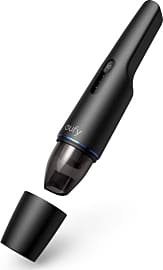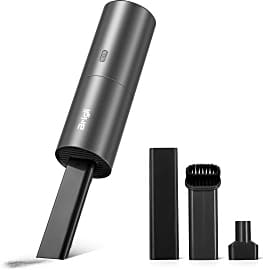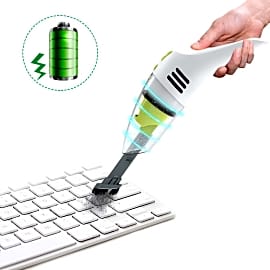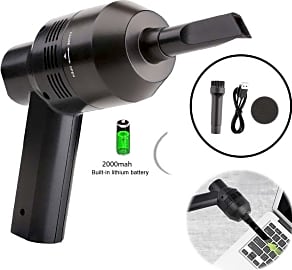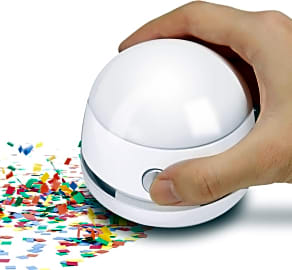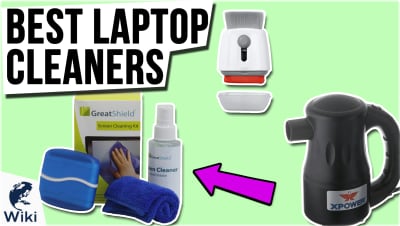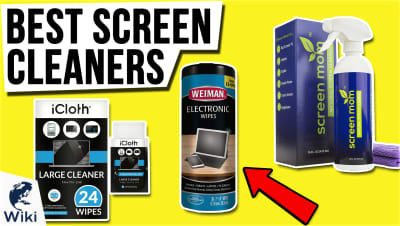The 8 Best Computer Vacuums

This wiki has been updated 35 times since it was first published in March of 2016. All that Cheetos dust on your keyboard doesn't just look ugly and attract ants, it can start to impede the mechanisms and cause you all sorts of problems. These mini computer vacuums can keep all your electronics free from debris that might end up making its way into the crevices of your hardware, and some of them even double as blowers to replace costly and environmentally-unfriendly canned air. When users buy our independently chosen editorial picks, we may earn commissions to help fund the Wiki.
Editor's Notes
November 05, 2020:
For this update we first had to deal with a few items that were facing availability issues, such as the Metro DataVac and Ehoyal 2-in-1. Since these options were still worthy of a spot on our list despite being out of stock we replaced them with the Metro DataVac Pro and Brigii Mini Vacuum respectively, both of which are nearly identical to the previous entries.
The Anker Eufy H11 is now the newest entry on our list, and it's a great midrange choice that sits between small budget options like the DealsWin Cleaner and large pro models like the XPower A-5 in terms of price and build quality. It's definitely one of the sleekest selections on the market, so those who care deeply about the aesthetics of their workspace will appreciate its ability to sit on or around their desk without sticking out like a sore thumb.
We added the ZesGood 7000PA as a general purpose option for those who would like something that can be used to clean small messes all over their house in addition to getting crumbs off their keyboard. It possesses a few interesting features that aren't found on most models, which will make it an especially good pick for some. For instance, integrated LEDs light up whatever you're vacuuming, which is very useful for cleaning the inside of your computer's case. This makes it easy to see the dust bunnies that lurk in dark crevices without needing a phone or flashlight in your other hand.
As good as the aforementioned options are high-end selections like the XPower A-5 and Metro DataVac Pro are still the best bet for those involved in electronics repair, or anyone else who might be cleaning computers on a very frequent basis. While small handheld models are adequate for those occasionally cleaning their keyboards, the suction power of portable options is dwarfed by stationary devices like these. Their selection of cleaning tips is also generally superior in terms of variety and quality.
If you're obsessed with having a clean PC, check out our article on the best screen cleaners after selecting the best vacuum for your needs.
December 06, 2019:
A good computer vacuum should be small and powerful yet still gentle enough to avoid harming electronics. It's also important to have some kind of brush attachment to help remove caked-on dust. The XPower A-5 is possibly the best corded model, in part because it also functions as a reasonably powerful blower, making it an environmentally friendly alternative to canned air. The Metro DataVac is similarly effective, although it's quite expensive for what's ultimately a somewhat limited tool. The Carpet Pro SCT-1 is another highly capable option that runs on AC power, and though it tends to get hot, it does shut off automatically upon overheat, which should help to extend its lifespan.
If you're looking for something a bit more convenient, the Ehoyal 2-in-1 is one of the most versatile cordless models. It, too, is reversible, though it doesn't have quite as much power as the plug-in models. The Meco Mini and DealsWin Cleaner both have relatively ergonomic shapes and should be pretty easy to get into small spaces. Then there's the Meco Desktop; while it's not capable of cleaning the inside of a desktop PC, it's a great option for lightly scrubbing the gunk out from between the keys of your keyboard or laptop. Also, there's a reasonable selection of additional cleaning tools on the market designed to keep your notebook computer and its screen free of dust and smudges.
A Brief History Of Computer Vacuums
British manufacturer Walter Griffiths invented the first truly portable vacuum cleaner in 1905.
While the name has a modern connotation, computer vacuums are actually based partly on technology developed more than a century ago.
The mechanical carpet sweeper, patented in 1876 by Melville Bissell, is considered the earliest ancestor of today's computer vacuums. When pushed, roller brushes inside the entirely man-powered sweeper would kick up dirt from the floor and direct it inside a container. The New York-born entrepreneur died of pneumonia in 1889, but his name lives on in the company he founded, which is now among the largest vacuum manufacturers in the world.
Introduced in 1900, the first powered cleaners were massive, ungainly industrial models that pushed air into a dust collector. Powered by an internal combustion engine, one of these cleaners had to be transported by horse-drawn wagon.
Powered suction vacuum cleaners, which pulled air rather than pushed it, were invented separately in 1901 by the British engineer Hubert Cecil Booth and American inventor David T. Kenney. Booth was the first to call his cleaning device a "vacuum cleaner." Still, like their predecessors, both vacuums were enormous, and impractical for private use. Kenney's even required a 2,000 pound steam engine for power.
British manufacturer Walter Griffiths invented the first truly portable vacuum cleaner in 1905. Called "Griffith's Improved Vacuum Apparatus for Removing Dust from Carpets," it was the first device suitable for domestic use. Easy to store and clean, Griffiths' vacuum called for the operator to contract a bellows to suck up air.
Though no modern company bears his name, the first portable electric vacuum cleaner was invented by American department store janitor James Murray Spangler in 1907. Spangler's creation paired the rolling brush of carpet sweepers with vacuum suction that pulled debris into a pillow case. Unable to bring his invention to market, Spangler sold the patent to leather goods manufacturer William Henry Hoover, whose name is now synonymous with the vacuum cleaner.
When The Hoover Company released the Model O in 1908, the market for domestic vacuum cleaners was ignited. The Model O was the first in a line of upright suction sweepers that continues today.
As the market grew after World War II, companies worked to improve their vacuum cleaners, and many specialized models were introduced, including the first rechargeable hand-held models, which were popularized in the 1980s and 90s.
These hand-held models were further refined as the PC grew in popularity, eventually becoming the specialty computer vacuum.
How Do Vacuum Cleaners Work?
Suction is the key to vacuum cleaner operation.
Suction is generated when the pressure outside the vacuum is greater than the pressure inside. This negative pressure effect is created by an electric fan, which pulls air out of the cleaner. When the head of the vacuum rolls over the floor, the pressure difference forces air and dirt into the hose.
This negative pressure effect is created by an electric fan, which pulls air out of the cleaner.
Because it is mixed with dust from the ground, this air can contain dangerous contaminants. For this reason, filters are critical to the safe operation of a vacuum cleaner. It is important to read the documentation included with a new vacuum cleaner, as it indicates best practices for filter maintenance. With proper care, today's vacuum cleaners are safe and effective, and can even be used to eradicate fleas.
Many upright vacuum cleaners filter air through a disposable fabric or paper bag, which allows air and little else to escape.
Unlike standard household models, most computer vacuums store the debris they collect inside a reusable compartment. This compartment can either be detached from the cleaner or opened for debris removal and cleaning. They share this quality with much larger wet/dry vacuum cleaners, which also feature reusable containers.
Take special care when using a computer vacuum on more than peripherals, because all vacuums generate static electricity. It is important to make certain the vacuum you will use features anti-static technology. Otherwise, you risk damaging the internal components essential to your machine's operation.
With any vacuum, it is possible to damage items on the floor or cause an electrical hazard by sucking up wires or operating on a wet surface. Be aware of your surroundings, and remove any cables, cords, wires, and property at risk of being damaged.
Vacuum Cleaner Design and Precautions
While popular in the United States, upright vacuum cleaners are actually rare in much of Europe. Mainland Europe favors the wheeled canister design, which separates the dust collector from the motor. Known in the United Kingdom as the cylinder model, this canister design is considered just as effective at cleaning as the upright models preferred in America.
Today's hand-held vacuum cleaners are often battery-powered, and feature reusable debris containers.
However, thanks to a flexible hose, canister models are often more maneuverable than upright models. Many commercial drum vacuums borrow heavily from the canister design for this reason. Larger drum models can store more 50 gallons.
In commercial applications where liquid waste is anticipated, there is the wet/dry vacuum cleaner, a variation of the drum model designed to handle wet and dry debris.
Another popular model in commercial settings is the backpack vacuum, which is regarded as the nimblest of the heavy duty cleaners.
Other contemporary designs are the robotic vacuum, the portable cyclonic vacuum brought to market by British inventor James Dyson, the central vacuum system built into larger buildings, and the vehicle-mounted vacuum truck.
Due to widespread carpeting, portable vacuums like the upright and the canister are significantly more popular in the West.
Today's hand-held vacuum cleaners are often battery-powered, and feature reusable debris containers. The computer vacuum, a specialized version of the hand-held model, frequently boasts bristles and other exchangeable tips that make cleaning inside crevices and around computer keys easy.


